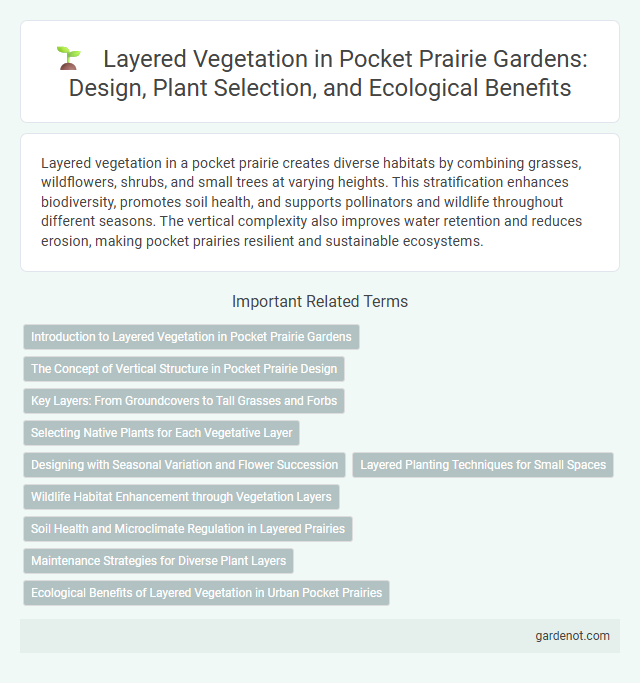Layered vegetation in a pocket prairie creates diverse habitats by combining grasses, wildflowers, shrubs, and small trees at varying heights. This stratification enhances biodiversity, promotes soil health, and supports pollinators and wildlife throughout different seasons. The vertical complexity also improves water retention and reduces erosion, making pocket prairies resilient and sustainable ecosystems.
Introduction to Layered Vegetation in Pocket Prairie Gardens
Layered vegetation in pocket prairie gardens mimics natural prairie ecosystems by incorporating multiple plant strata, including grasses, forbs, shrubs, and small trees. This diverse vertical structure enhances habitat complexity, promotes biodiversity, and improves soil health through varied root systems. Incorporating native species in distinct layers supports pollinators, bird populations, and resilient plant communities well-adapted to local conditions.
The Concept of Vertical Structure in Pocket Prairie Design
Vertical structure in pocket prairie design maximizes biodiversity by layering vegetation from ground cover to tall grasses and shrubs, creating multiple habitats within a compact space. This stratified arrangement enhances ecological functions such as soil stabilization, nutrient cycling, and pollinator support. Incorporating diverse plant heights and forms fosters resilience and boosts ecosystem services in urban green spaces.
Key Layers: From Groundcovers to Tall Grasses and Forbs
Layered vegetation in pocket prairies includes key layers such as groundcovers, medium-height forbs, and tall grasses, each contributing to biodiversity and ecosystem stability. Groundcovers like native sedges and creeping thyme stabilize soil and retain moisture, while tall grasses such as big bluestem and switchgrass provide habitat and support pollinators. This stratified structure enhances nutrient cycling, carbon sequestration, and resilience against invasive species.
Selecting Native Plants for Each Vegetative Layer
Selecting native plants for each vegetative layer in a pocket prairie enhances biodiversity and ecosystem resilience. Herbaceous groundcovers like Little Bluestem and Prairie Dropseed provide soil stabilization, while mid-layer shrubs such as American Hazelnut and New Jersey Tea offer habitat and food sources for pollinators and birds. Overstory trees like Eastern Redbud and Bur Oak create shade and shelter, supporting a dynamic and self-sustaining plant community.
Designing with Seasonal Variation and Flower Succession
Layered vegetation in pocket prairies maximizes biodiversity by incorporating diverse plant heights and root structures that support pollinators and soil health year-round. Designing with seasonal variation ensures continuous color and habitat value by selecting species that bloom and thrive in different seasons, from early spring wildflowers to late-fall grasses. Flower succession extends bloom periods, enhancing visual interest and ecological support by staggering flowering times among native species such as coneflowers, black-eyed Susans, and goldenrod.
Layered Planting Techniques for Small Spaces
Layered planting techniques maximize biodiversity and ecosystem functions in pocket prairies by incorporating multiple vegetation strata, including ground cover, herbaceous plants, shrubs, and small trees. This vertical diversity enhances habitat for pollinators and wildlife while improving soil health, moisture retention, and erosion control in small urban or residential spaces. Strategic layering of native species with varying root depths and growth habits creates resilient, low-maintenance landscapes that mimic natural prairie ecosystems.
Wildlife Habitat Enhancement through Vegetation Layers
Layered vegetation in pocket prairies creates diverse habitats that support a wide range of wildlife by offering varied food sources, shelter, and nesting sites. The multi-tiered structure--from ground cover to tall grasses and flowering shrubs--enhances biodiversity and promotes ecological balance. This stratification improves microclimates and soil health while attracting pollinators, birds, and beneficial insects critical to sustaining resilient ecosystems.
Soil Health and Microclimate Regulation in Layered Prairies
Layered vegetation in pocket prairies enhances soil health by promoting diverse root structures that improve soil aeration and nutrient cycling. These layers create microclimates that regulate temperature and moisture levels, fostering resilient plant growth and supporting beneficial soil microorganisms. This dynamic interaction between vegetation layers and soil contributes to increased carbon sequestration and reduced erosion.
Maintenance Strategies for Diverse Plant Layers
Layered vegetation in pocket prairies thrives through targeted maintenance strategies that include selective mowing, periodic weeding, and controlled burning to promote biodiversity and plant health. Implementing varied cutting heights preserves ground cover and supports pollinator habitats across herbaceous, shrub, and tree layers. Regular monitoring ensures invasive species are managed, encouraging resilience and sustained ecological balance within the layered plant structure.
Ecological Benefits of Layered Vegetation in Urban Pocket Prairies
Layered vegetation in urban pocket prairies enhances biodiversity by providing diverse habitats for pollinators, birds, and beneficial insects. This stratification improves soil health through increased organic matter and root diversity, which promotes water infiltration and reduces erosion. By supporting various plant heights and species, layered vegetation contributes to microclimate regulation, mitigating urban heat island effects and improving air quality.
Layered vegetation Infographic

 gardenot.com
gardenot.com